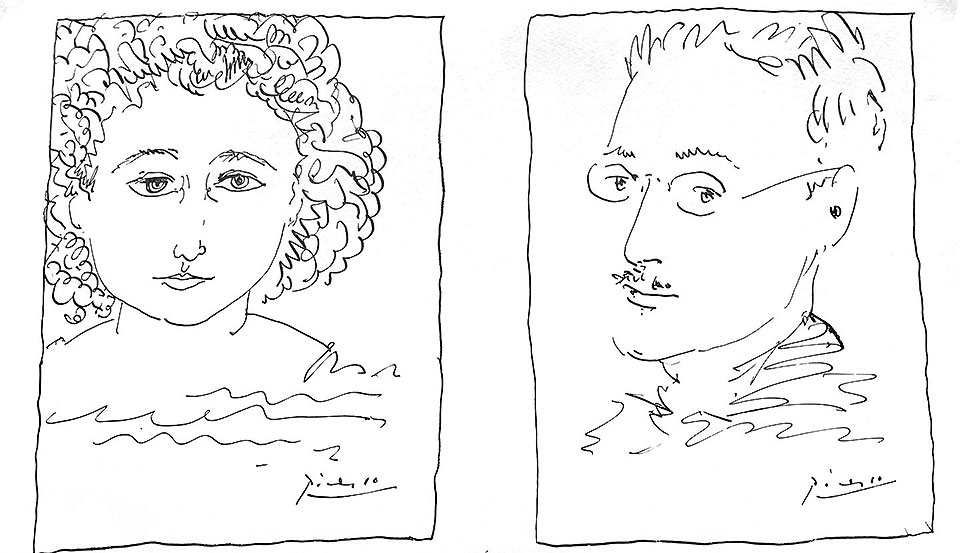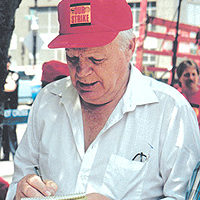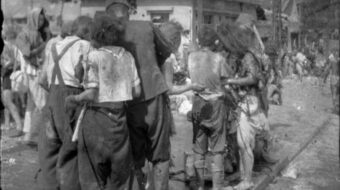
Think back to the political climate of the early 1950s: Senator Joseph McCarthy on the prowl. Alger Hiss was convicted of “losing China.” Eleven leaders of the Communist Party were convicted of “conspiracy to teach and advocate the violent overthrow of the United States.” A U.S. attack on North Korea. And, to top it off, the successful test of an atomic weapon by the Soviet Union. As one contemporary writer put it, “It was a tough time to be an accused spy, especially one accused of spying for the Soviet Union.”
Such was the fate of Julius and Ethel Rosenberg, arrested in the summer of 1950 and charged with conspiracy to commit espionage. After a month-long trial in March 1951 and a single day of deliberation, a jury of 11 men and one woman found the pair guilty. On April 5, Federal Judge Irving Kaufman sentenced the Rosenbergs to death. Their co-defendant, Morton Sobell, (also charged with conspiracy) was sentenced to a 30-year prison term. Kaufman set the execution date for the week of June 21, 1951.
Because the charge was conspiracy, prosecutors were not required to provide tangible evidence that the Rosenbergs had stolen anything or given anything to anybody.
The government fought to have the case tried in a federal court where a conspiracy charge could be proven by the non-corroborated testimony of a single witness. Most states, including New York, would have required testimony from at least two witnesses not involved in the alleged conspiracy, to obtain a conviction.
In the Rosenberg case, it was enough that other members of the alleged conspiracy – in this case, David Greenglass (brother of Ethel) and his wife, Ruth – testify that the Rosenbergs were co-conspirators. In return for her husband’s cooperation in framing the Rosenbergs, Ruth Greenglass (who swore she helped steal what the prosecution called “the most important scientific secret ever known to mankind”) was never even indicted. David Greenglass was given 15 years.
In a statement justifying his decision to impose the death sentence on the Rosenbergs, Kaufman said, “I consider your crime worse than murder. … I believe your conduct in putting into the hands of the Russians the A-bomb years before our best scientists predicted Russia would perfect the bomb has already caused, in my opinion, the Communist aggression in Korea, with the resultant casualties exceeding 50,000 and who knows but that millions more of innocent people may pay the price of your treason. … [Y]ou are hereby sentenced to the punishment of death.”
Despite Kaufman’s claim – echoed by President Eisenhower when he denied clemency – no atomic scientist ever said the Soviets had perfected their bomb more quickly than expected. In fact a chorus of scientists, including Nobel Prize winner Harold Urey and J. Robert Oppenheimer, repeatedly said there was no “secret” to the atomic bomb.
Emanuel Bloch, the Rosenbergs’ attorney, had mistakenly moved to have Greenglass’ rude sketches of the atomic bomb sealed, thus making it impossible for scientists to view them until years after the Rosenbergs had been killed. Once they did, however, they agreed with a colleague’s assessment that the drawings were “too incomplete, ambiguous and even incorrect to be of any service or value to the Soviets in shortening the time required to develop their nuclear bombs.”
In addition, the Soviet Union (a recent ally of the U.S. in World War II) had received 30,000 copies of the “Official Report of the United States Government on Atomic Energy Development for Military Purposes” that was issued in 1945. It is said that professionally trained scientists could clearly understand the structure of the bomb merely from studying this book.
The death sentence against the Rosenbergs, however, remained in place.
The following two years saw the development of a worldwide campaign demanding mercy. In the last days before the execution of the Rosenbergs, the Eisenhower administration ignored clemency pleas from leading personalities from around the world, including Pope Pius XI; Vincent Auriol, president of France; Albert Einstein, and several Nobel Laureates.
A week of frenzied – and desperate – activity began on June 13, 1953, when the Supreme Court refused to hear the Rosenbergs’ appeal. Then came appearances before Judge Kaufman and before Supreme Court Justice William O. Douglas, requesting a stay of execution. A petition for clemency was also sent to the White House.
Prior to recessing for the summer, the justices made a “gentlemen’s agreement” that no justice would issue a stay on his own and that the full court would be reconvened should the agreement be broken. On Tuesday, June 16, Chief Justice Fred Vinson and Attorney General Herbert Brownell agreed that if Douglas granted a stay of execution, Vinson would immediately convene a special session of the court to overturn the stay. Furthermore, at Brownell’s suggestion, Vinson agreed to meet privately with Douglas in an effort to convince him not to decide the merits of the new motion himself but to submit the motion for consideration in conference.
But Justice Douglas granted a stay on June 17, basing his decision on the fact that “one of the requisites for imposing the death penalty under the 1946 Atomic Energy Act is that it can only be imposed if the jury recommends it,” something the jury hadn’t done.
Vinson then swung into action, and for only the third time in its history, the Supreme Court was reconvened after it had already adjourned for vacation. (Neither the defense attorneys nor Justice Douglas were notified that this meeting was to take place.) And for the first time in its history, a stay by one of the judges was vacated by the other members of the court. The vote was 6 to 3.
Among the Supreme Court Justices willing to stay the executions, Hugo Black wrote: “It is not amiss to point out that this court has never received this record and has never affirmed the fairness of the trial. Without [that] … there may always be questions as to whether these executions were legally and rightfully carried out.”
When a group of lawyers petitioned Attorney General Brownell to postpone the executions for 24 hours so that they not take place on the Jewish Sabbath, Brownell assured them there would be “no executions carried out through the Sabbath.”
Defense lawyers surmised this meant the executions would not take place before Saturday night, June 20. But Brownell had other plans. He called Wilfred Denno, warden of Sing Sing prison, and changed the date, not to after the Sabbath on June 20, but to before the Sabbath at 8:00 p.m., June 19.
That the executions were carried out on the eve of the Jewish Sabbath is indicative of how absolutely determined the federal government was to first frame, and then execute, the Rosenbergs.
Although he twice refused to grant a stay of execution, President Eisenhower kept a telephone line with the warden at Sing Sing Prison open in the minutes before 8:00 p.m. on June 19, hoping that either Ethel or Julius would reconsider their refusal to plead guilty to a crime they had not committed when faced with imminent death.
Authorities had long hoped that they could play Julius and Ethel against one another in order to force a confession from Julius and then use that confession to prosecute an ever-widening number of “spies.”
Soon after Julius’ arrest, J. Edgar Hoover said there was “no question” that, if “Julius Rosenberg would furnish details of his … espionage activities, it would be possible to proceed against other individuals. [P]roceeding against his wife might serve as a lever in this matter.” The government’s cynicism was boundless.
The dreadful hour drew near. Vigils demanding clemency were held in over 50 cities worldwide. Once again the White House refused to intervene. The Rosenbergs were executed shortly after 8:00 p.m., with Julius being the first. They were buried on June 21.
On Sept. 22, 1953, Emanuel Bloch released the following statement made earlier by his client, Julius Rosenberg:
“This death sentence is not surprising. It had to be. There had to be a Rosenberg Case because there had to be an intensification of the hysteria in America to make the Korean War acceptable to the American people. There had to be a hysteria and a fear sent through America in order to get increased war budgets. And there had to be a dagger thrust in the heart of the left to tell them that we are no longer gonna give five years for a Smith Act prosecution or one year for Contempt of Court, but we’re gonna kill ya!”
(See related story below)
* * * * * *
Robert Meeropol: We celebrate resistance
By Fred Gaboury and Susan Webb
Robert Meeropol is the younger son of Ethel and Julius Rosenberg. He and his brother, Michael, took the name of their foster parents when they were adopted by Abel and Anne Meeropol in 1957. We talked to Robert on June 6. We began by asking about the upcoming “Celebrate the Children of Resistance” set for June 19 at the City Center in Manhattan.
“Why a celebration?” we asked.
“It may sound strange that we are celebrating the resistance of Ethel and Julius Rosenberg rather than bemoaning their murder,” said Meeropol. “But they died because they resisted. In order to save their lives, they had to confess to a crime they never committed, and when they refused to do that they were killed.”
Meeropol added that the event is meant to unite the struggles of the ’50s with the struggles of today. “Resistance needs to be celebrated because it is important today – probably as important today as it has ever been.”
Meeropol told of the long-time co-worker who called him recently to say that the repression of the 1950s was “much worse” than that of today. “I refuse to debate that question. The fact is the Smith Act and the Patriot Act are both bad. When we look at what’s happened since Sept. 11, we are going backwards when it comes to civil liberties.”
Several times during the interview Meeropol referred to what he called the “re-emergence of McCarthyism.”
“Take a look at the Smith Act or the McCarran Act and substitute ‘terrorist’ for ‘communist’ or ‘subversive.’ When you do that you’ll find very little difference between these laws and the Patriot Act.”
Meeropol accused Attorney General John Ashcroft of “working to erect barriers” to any opposition to the foreign policy adventures of the Bush administration.
“Look at the effort of New York City police to corral demonstrators separated during the million-member peace demonstration of Feb. 15. And it was all done for ‘national security,’” he said. “It reminded me of the evening of June 19, 1953, when New York City refused to honor a permit for a vigil in Union Square. Police on horseback herded people into the street – and this despite the fact that a permit to assemble in the park had been granted.”










